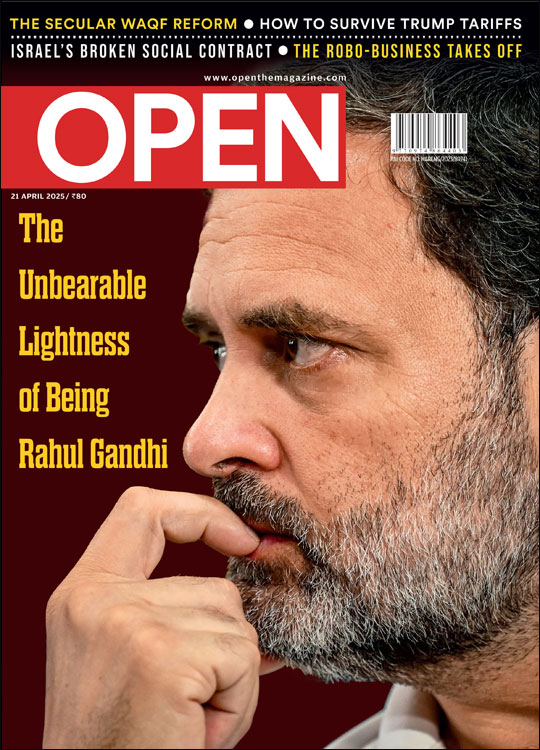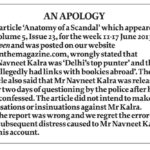The Dark Side of Asaram Bapu
His comments on rape were merely the tip of a sinister iceberg
 Haima Deshpande
Haima Deshpande
 Haima Deshpande
|
30 Jan, 2013
Haima Deshpande
|
30 Jan, 2013
/wp-content/uploads/2015/11/asa1.jpg)
His comments on rape were merely the tip of a sinister iceberg
Less than 35 kilometres from the centre of Ahmedabad lies the dusty town of Motera, now made famous by one of India’s best known spiritual gurus, self-styled philosopher and friend to the rich and the powerful. Nearly 42 years ago, a developing friendship with the powers that be in Gujarat earned Asaram Harpalani, the son a coal and wood seller, 10 acres of fertile agricultural land. The land did not come to him all at once, it accumulated over the years as friendships strengthened. Harpalani, who was born in 1941 in Berami village of Pakistan’s Sindh province, set up a small ashram on the land, the first of over 400 ashrams that exist today across the world. Soon enough, this self-styled religious preacher dropped his tongue twister of a surname and began calling himself Asaram Bapu.
His controversial intervention in the Delhi rape case—when he said “galati ek taraf se nahin hoti hai,” suggesting the victim of the sexual assault was equally responsible for the crime—has recently brought unwanted national attention to the man, but in Gujarat, Asaram and his Motera ashram have been in the eye of a storm since July 2008. The controversy involves the deaths of two ten-year-old cousins, Abhishek and Dipesh Vaghela, at the ashram’s Bal Kendra, on 3 July, a month after they were admitted there as students. On 23 January this year, seven disciples of Asaram accused in the Vaghela case were summoned by an Ahmedabad court.
In the aftermath of the disappearance of the Vaghela brothers from the heavily guarded Bal Kendra, the ashram administration, including Asaram and Darshan Sai, had initially played down the seriousness of the incident. The parents of the children were told that they had run away home, a fact vociferously contested by them. “My brother Shantibhai and I enrolled our children at the Motera ashram for education,” said Praful Vaghela, father of Dipesh.
“We paid Rs 15,000 each but were not given pucca receipts. It was just a handwritten receipt. The children were given yellow T-shirts and white pajamas as uniform in the ashram. In that month, we visited them at least six to eight times. On 28 June, when we visited the ashram, their hair was tonsured and both had sandalwood tikas on their foreheads. I was uncomfortable with this,” said Vaghela. According to him, the children told him that the tonsuring was done in the presence of Asaram. On the afternoon of 3 July, Shantibhai met the children at the ashram. At 9 pm the same day, Praful Vaghela received a call from the ashram administration inquiring if the children had come home. The Vaghelas went to the ashram and looked for the children. At the end of their futile search, Pankaj Saksena, the administrator of the gurukul told them to go around a peepal tree 11 times and ask for the children.
They did so but “nothing happened”. The family, Vaghela claimed, wanted to file a police complaint, but the Ashram administration did not allow them to do so. The family waited out the night and proceeded to the Chandkeda police station the next morning. Two office bearers of the ashram—Vikas Khemcha and Ajay Shah—were already there at the police station. “They went in and spoke to the police. Then they came out and told us to go inside. The police got angry with us when we demanded that a complaint be filed. They did not let us file one,” says the distressed father.
During this period Asaram sent a message to the parents that they should go to a char rasta (crossroad), pick up seven stones, put the stones in hot water along with the children’s clothes and then take out the wet clothes inside out and hang them to dry in the children’s room. The children would return within four hours. “The ashram people told us to wait for the mandatory four hours as directed by Asaram. Nothing happened,” said Vaghela. On the third day of the search, the ashram administration told the Vaghelas another bizarre story—the thumbnail of a 10-year-old gurukul resident had indicated that the missing children were at Kallol. Not surprisingly, that was not where the children were found. Their bodies were finally recovered from a dried-up riverbed close to the ashram.
Vaghela can still vividly recall the harrowing sight—his son Dipesh’s arms were missing from the shoulder down. All the internal organs were missing, only the hollowed out ribcage remained. His left leg appeared to be cut off at the ankle, the right leg seemed burnt. His nephew Abhishek’s body was half burnt as well. Instead of helping the family, the policemen harassed them and refused to register complaints against Asaram and the ashram. “When I said the guilty should be arrested, we were told the consequences could be dire. Then we saw a tempo full of ashram inmates coming to the place where the bodies were recovered, armed with weapons and sticks. We ran away,” said Vaghela. Till this point, Asaram had always enjoyed a cosy relationship with the media. But when the media started reporting on the Vaghela case, many other skeletons started tumbling out of the ashram closets. The media, including several women reporters, were targeted and mercilessly beaten up. Kuldeep Singh Kalair, a reporter with Divya Bhaskar, was locked up in a room in the ashram and beaten by sadhaks. He had to be rescued by the police.
The incident served to lend credence to the allegations of tantric practices by Asaram and his followers. The rumours had been around for a while, but before the deaths of these boys these were mere whispers. Meanwhile, in the Chhind- wara town of Madhya Pradesh, two other children were found dead in the residential institution run by Asaram. The students—Ramakrishna Yadav (a nursery student) and Vedant Moraya (Class 1 student)—were found in the hostel toilet on 31 July 2008. Here too, angry residents protested and demanded the closure of the ashram.
Vaghela continues to maintain that Asaram and his son are involved in black magic and tantric practices, a claim he has made in his deposition before the Justice (retired) DK Trivedi Commission of Inquiry. The Commission, appointed by Gujarat Chief Minister Narendra Modi to probe the deaths following the public outcry, has already been censured by the Gujarat High Court for going soft on Asaram and his son. The high court order on a petition filed by Asaram (15637/2012), challenging the Commis- sion summons to appear before it, stated: “a picture emerges where the Commis- sion has, on its knees, with folded hands craved the convenience of the petitioner and his son to record their evidence before it and this has continued for a period of more than one and a half years”. When Asaram appeared before the Commis- sion, after being summoned on six different occasions, he was accompanied by an entourage of slogan-shouting followers. Eyewitnesses say that even as the deposition before the Commission was on, Asaram would leave the room without permission, either to drink milk or address his followers.
This brazenness in the face of the law is in keeping with this guru’s attitude to life. Initially, after the Motera ashram was set up, the numbers who came to listen to him were not large, but as local politicians started paying obeisance, they swelled. At the core of his attraction was an aggressive discourse that preached an ethic of ‘tit for tat’. The attitude is still visible at the sprawling Motera ashram.
Beyond a huge peach-coloured arch, plastered with flex banners of the white-bearded preacher in elaborate head gear, two listless guards in khaki uniform watch people enter and exit the ashram. Many prostrate themselves at the ashram entrance before entering or leaving. Asaram speaks to the people via recorded discourses heard through the ashram compound, but few who come into the ashram seem interested in listening to the recorded version. It is the white kurta-pajama-clad male disciples, spread across various age groups, who catch their attention. They are everywhere—behind the various counters, walking around, talking in groups and working. They speak rough even with each other and some even use colourful expletives to make a point.
At the far corner of the ashram stands the heavily guarded Bal Kendra. The presence of the guards is in keeping with the fear the name of Asaram invokes among present-day and former disciples when they discuss the godman. Two who have shared a close rapport with Asaram—Raju Chandak, a secretary, and Amrut Prajapati, personal physician—are running scared ever since they called it quits. Both claim to be privy to numerous illegal activities at the ashram. While Chandak has been shot at and wounded by three bullets following his deposition before the Trivedi Commission, Prajapati says he has been attacked at least six times by the ashram goons. Both are scared of sting operations done by the ashram, which have been furnished as proof before investigating agencies. Speaking to Open on telephone, a scared Chandak kept demanding proof that this reporter was not a part of a sting operation. “Asaram and his goondas have ruined my family life. We are running all the time because he has threatened to eliminate me. An attempt was also made. There is sexual exploitation going on at the ashram. I am being attacked because he does not want the illegal activities made public,” said Chandak.
Prajapati spoke to Open at the Ayurveda Yog Centre in Ahmedabad’s Odav Circle. Responding to an advertisement for an ayurvedic doctor at one of Asaram’s ashrams, the BAMS-educated Prajapati met the godman for the first time in 1988. He was offered Rs 15,000 a month for a job that included food and accommodation. “I was entrusted with the job of setting up their ayurvedic formulation laboratory and allied services at the Surat ashram,” said Prajapati. As the number of disciples grew, Prajapati says Asaram insisted that they compromise on the quality of raw material used to prepare medicines. “Cow’s ghee was replaced by mixed ghee. I am also a witness to corruption and womanising. I saw these things closely when I became his personal physician. I could go to Asaram’s room at any time. One afternoon I went to his Jatikara farmhouse in Delhi. This was the day after his mother died. There was a woman in the room and it was a sight I should not have seen,” said Prajapti.
“On 20 August 2005 I left the ashram after being threatened by them. I was scared. In September 2005, I was attacked by 10-15 people when I was visiting a friend in Ghaziabad. They threatened to kill me if I spoke against Asaram or the ashram. After the attacks I do not inform my patients about my schedule. I don’t even tell my family about my travel plans. This is the price I’m paying for the inability of the Gujarat police to protect me. There will never be justice. Even the Trivedi Commission will not be able to do anything to Asaram,” said Prajapati.
The death of the boys is not the only allegation of wrongdoing against Asaram and his ashram. The cases against him range from the sinister to the bizarre, from land grab (in February 2009, the Gujarat government admitted in the legislative assembly that the Asaram ashram had encroached on 67,099 sq. m of land in Ahmedabad) to this allegation by a man blinded in one eye during a discourse, who has alleged that toffees were showered from a high-speed rotating machine at those in attendance. One such toffee hit him in the eye.
Ashram spokesman Uday Sangani, an accused in the Vaghela case, dismisses the cases against Asaram and his associates as politically motivated. “It is perceived that Bapuji is close to the BJP due to his Hindutva teachings, hence the Congress has started this harassment.” He has been associated with the ashram for the past 17 years.
About The Author
CURRENT ISSUE
The Unbearable Lightness of Being Rahul Gandhi
MOst Popular
3

/wp-content/uploads/2025/04/Cover-Congress.jpg)











More Columns
Finding Ferdinand Kittel Babli Yadav
Ukraine silently encroaches on ‘friendly’ Moldova Ullekh NP
NFRA chief Ajay Pandey joins AIIB Rajeev Deshpande